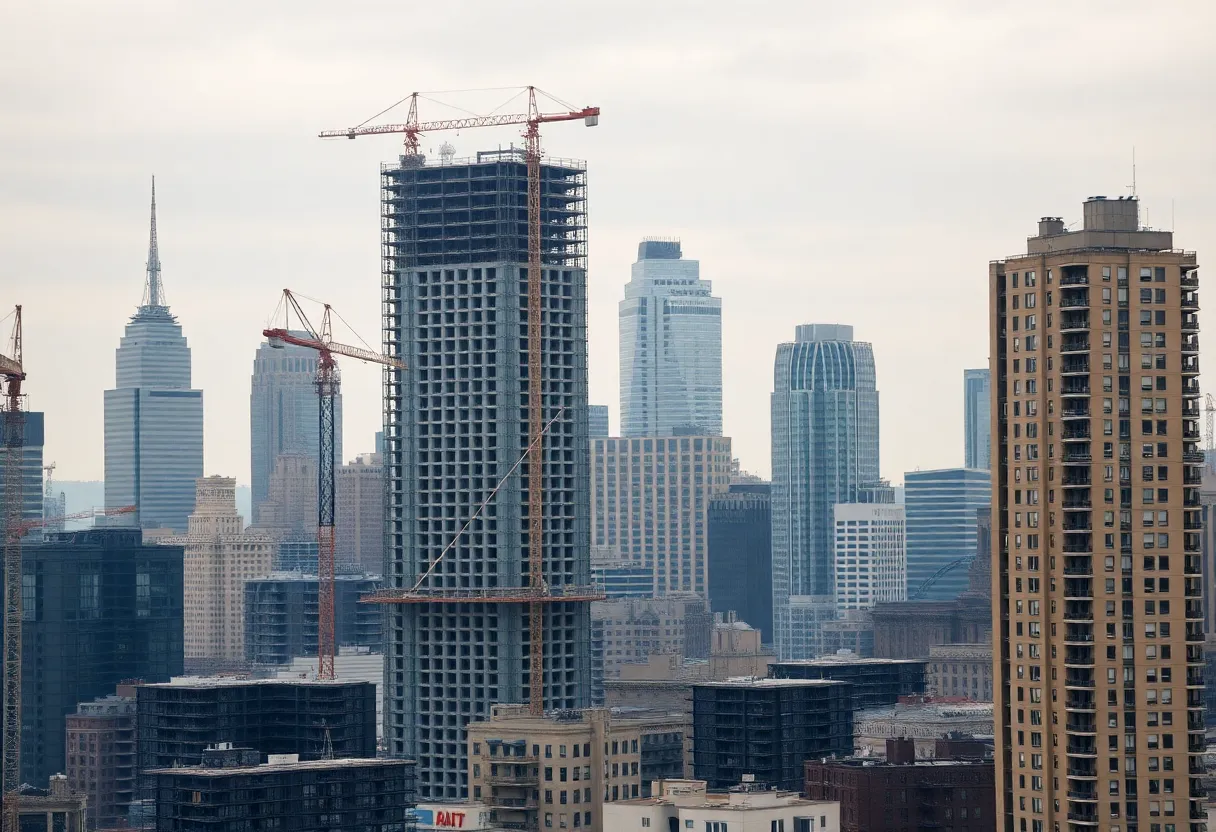New York City, October 6, 2025
News Summary
New York City has seen a sharp decline in new market-rate apartment construction, with quarterly housing starts falling from 7,500 to 2,500 units — a 67% decrease. Units under construction dropped from 71,000 to 47,000, driven by the replacement of the 421a tax abatement with the stricter 485x program, higher land and union labor costs, and tighter wage rules. Developers are leaning into conversions (8,310 units in the pipeline) and renovating existing buildings. Rent growth remains 2.7%, while construction wages and input prices have risen, adding pressure on new ground-up projects.
New York City housing starts down 67% this year after 485x replaced 421a; construction slows as conversions and higher contractor pay reshape supply
Housing construction in New York City has plunged, with starts for market-rate apartments falling sharply after the older tax break was replaced by the new 485x program. The decline has been dramatic: an average of 7,500 units per quarter (2021–2024) dropped to just 2,500 units per quarter this year, a 67 percent decrease in housing construction starts. The total number of apartment units under construction fell from 71,000 to 47,000 in the referenced period.
Why starts fell
The new 485x program replaced the expired 421a and shifted incentives toward stricter affordability and labor standards. The change increased costs and added wage and targeting requirements that many developers find hard to absorb. In a city already described as one of the most expensive places to build, higher land prices and steep union labor costs have amplified the pullback in new development.
Developers shifting strategies
With returns reduced on new construction, many investors are choosing existing buildings over ground-up projects. There is an increased trend of buying market-rate apartment buildings as a simpler investment than building new supply. Office-to-residential conversions are filling part of the supply gap: as of February, the city had 8,310 new housing units in the pipeline from conversions. Two large planned conversions could add as many as 1,250 and 1,600 units respectively.
Policy and market pressures
Developers cite government-related issues, including wage requirements and permitting, as major obstacles. About 40 percent of real estate professionals cited government-related issues as the top obstacle to development. Concerns over future mayoral policies are keeping some developers and investors on the sidelines until political direction becomes clearer.
Housing market context
Rent growth in the city is 2.7 percent this year, which is roughly double the national average. Apartment inventory growth lagged from 2020 to 2024, rising only 6 percent in the city while other U.S. cities saw more than 20 percent growth in the same period. The slowdown in new construction starts is reducing the pace of apartment inventory growth.
Contractors and labor
Separate industry research shows construction firms in New York are responding to a tight labor market by increasing pay and improving benefits. Wages rose by 12.4% on average among respondents, and many firms now offer cash bonuses and retirement plans tied to company performance. Over 90% of construction firms provide retirement plans, and about 79% of companies now offer cash bonuses. At the same time, companies report higher input prices — currently 0.8% higher than a year ago and more than 40% higher compared to February 2020.
Operational shifts and incentives
Contractors are adopting workforce development, flexible work options, mental health supports, and safety technology to retain staff. Many firms are not using available employment tax credits; roughly 82% of respondents were unaware of available federal and state employment tax credits. Industry analysts recommend combining clearer, longer-term tax incentives with demands for deeper, lasting affordability to restore developer interest in new construction.
What conversions mean
Conversions are drawing from older, lower-quality office stock that would be expensive to reposition as offices. That process can be simpler and cheaper for developers than borrowing to reposition or build new on scarce land. Reduced bureaucratic hurdles have made conversions more feasible, and the office recovery has focused largely on higher-quality, Class A buildings while vintage office properties struggle.
Bottom line
New construction starts for market-rate apartments in New York City have dropped substantially this year after the tax incentive program change. Developers face higher costs, stricter rules tied to the new program, and an uncertain political environment. Conversions and increased investment in existing buildings provide partial relief, while rising contractor pay and benefits reshape project economics and timelines.
FAQ
Q: How much did housing construction starts for market-rate apartments change?
A: Housing construction starts for market-rate apartments dropped from an average of 7,500 units per quarter (2021–2024) to just 2,500 units per quarter this year.
Q: What percent decrease does that represent?
A: The drop from 7,500 to 2,500 units per quarter represents a 67 percent decrease in housing construction starts.
Q: How did the total number of apartment units under construction change?
A: The total number of apartment units under construction in NYC fell from 71,000 to 47,000 in the referenced period.
Q: How many conversion units were in the pipeline as of February?
A: As of February, NYC had 8,310 new housing units in the pipeline from conversions.
Q: What large conversion projects are noted?
A: Major planned conversion: Apollo Global Management, SL Green Realty and RXR plan to convert 5 Times Square into as many as 1,250 housing units. Major planned conversion: Metro Loft Management and David Werner Real Estate Investments plan to convert the former Pfizer headquarters at 235 East 42nd Street into a total of 1,600 units.
Q: What has been the rent growth this year?
A: NYC rent growth is 2.7 percent this year.
Q: What share of real estate professionals cited government-related issues as the top obstacle?
A: According to CoStar, 40 percent of real estate professionals cited government-related issues (such as wage requirements and an onerous permitting process) as the “top obstacle to development.”
Q: What did the construction firm study report about wage growth?
A: Nancy Cox said wages have increased by 12.4% on average as labor shortages persist in the industry (per the study).
Q: How aware are firms of employment tax credits?
A: About 82% of respondents were unaware of available federal and state employment tax credits (study finding).
{
“@context”: “https://schema.org”,
“@type”: “FAQPage”,
“mainEntity”: [
{
“@type”: “Question”,
“name”: “How much did housing construction starts for market-rate apartments change?”,
“acceptedAnswer”: {
“@type”: “Answer”,
“text”: “Housing construction starts for market-rate apartments dropped from an average of 7,500 units per quarter (2021–2024) to just 2,500 units per quarter this year.”
}
},
{
“@type”: “Question”,
“name”: “What percent decrease does that represent?”,
“acceptedAnswer”: {
“@type”: “Answer”,
“text”: “The drop from 7,500 to 2,500 units per quarter represents a 67 percent decrease in housing construction starts.”
}
},
{
“@type”: “Question”,
“name”: “How did the total number of apartment units under construction change?”,
“acceptedAnswer”: {
“@type”: “Answer”,
“text”: “The total number of apartment units under construction in NYC fell from 71,000 to 47,000 in the referenced period.”
}
},
{
“@type”: “Question”,
“name”: “How many conversion units were in the pipeline as of February?”,
“acceptedAnswer”: {
“@type”: “Answer”,
“text”: “As of February, NYC had 8,310 new housing units in the pipeline from conversions.”
}
},
{
“@type”: “Question”,
“name”: “What large conversion projects are noted?”,
“acceptedAnswer”: {
“@type”: “Answer”,
“text”: “Major planned conversion: Apollo Global Management, SL Green Realty and RXR plan to convert 5 Times Square into as many as 1,250 housing units. Major planned conversion: Metro Loft Management and David Werner Real Estate Investments plan to convert the former Pfizer headquarters at 235 East 42nd Street into a total of 1,600 units.”
}
},
{
“@type”: “Question”,
“name”: “What has been the rent growth this year?”,
“acceptedAnswer”: {
“@type”: “Answer”,
“text”: “NYC rent growth is 2.7 percent this year.”
}
},
{
“@type”: “Question”,
“name”: “What share of real estate professionals cited government-related issues as the top obstacle?”,
“acceptedAnswer”: {
“@type”: “Answer”,
“text”: “According to CoStar, 40 percent of real estate professionals cited government-related issues (such as wage requirements and an onerous permitting process) as the “top obstacle to development.””
}
},
{
“@type”: “Question”,
“name”: “What did the construction firm study report about wage growth?”,
“acceptedAnswer”: {
“@type”: “Answer”,
“text”: “Nancy Cox said wages have increased by 12.4% on average as labor shortages persist in the industry (per the study).”
}
},
{
“@type”: “Question”,
“name”: “How aware are firms of employment tax credits?”,
“acceptedAnswer”: {
“@type”: “Answer”,
“text”: “About 82% of respondents were unaware of available federal and state employment tax credits (study finding).”
}
}
]
}
Key features at a glance
| Topic | Key fact | Value / detail |
|---|---|---|
| Construction starts (quarterly) | Average (2021–2024) | 7,500 units per quarter |
| Construction starts (this year) | Current average | 2,500 units per quarter |
| Percent change | Drop in starts | 67 percent decrease |
| Units under construction | Before vs after | 71,000 to 47,000 |
| Conversion pipeline | Units in pipeline | 8,310 units |
| Major planned conversions | Notable potential additions | 1,250 units and 1,600 units |
| Rent growth | Year to date | 2.7 percent |
| Contractor wage growth | Average increase | 12.4% |
| Awareness of tax credits | Respondent awareness | 82% unaware |
| Firms offering bonuses | Cash bonuses prevalence | 79% of companies |
Note: This article compiles market and industry findings about New York City housing starts, conversion projects, and construction firm responses to labor and cost pressures.
Deeper Dive: News & Info About This Topic
Additional Resources
- Commercial Observer: NYC apartment construction plummets
- Wikipedia: Housing in New York City
- Crain’s New York: NYC construction jobs still below pre-pandemic levels
- Google Search: NYC construction jobs 2025
- Construction Dive: How New York contractors fight labor shortages
- Google Scholar: construction labor shortages New York 2025
- Law360: NY construction co accused of layoff without proper notice
- Encyclopedia Britannica: layoff
- Long Island Business News: Long Island construction job decline
- Google News: NYC housing starts 485x 421a
Author: Construction NY News
NEW YORK STAFF WRITER The NEW YORK STAFF WRITER represents the experienced team at constructionnynews.com, your go-to source for actionable local news and information in New York and beyond. Specializing in "news you can use," we cover essential topics like product reviews for personal and business needs, local business directories, politics, real estate trends, neighborhood insights, and state news affecting the area—with deep expertise drawn from years of dedicated reporting and strong community input, including local press releases and business updates. We deliver top reporting on high-value events such as the New York Build Expo, infrastructure breakthroughs, and cutting-edge construction technology showcases. Our coverage extends to key organizations like the Associated General Contractors of New York State and the Building Trades Employers' Association, plus leading businesses in construction and real estate that power the local economy such as Turner Construction Company and CMiC Global. As part of the broader network, including constructioncanews.com, constructiontxnews.com, and constructionflnews.com, we provide comprehensive, credible insights into the dynamic construction landscape across multiple states.





